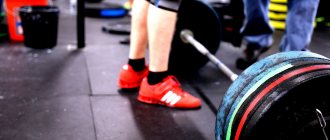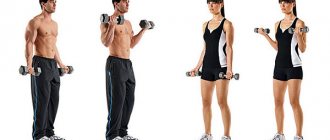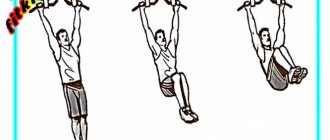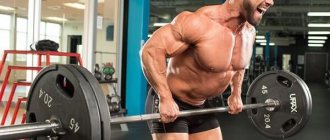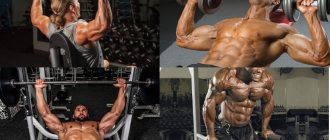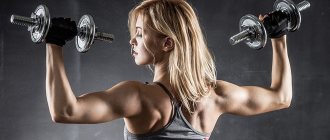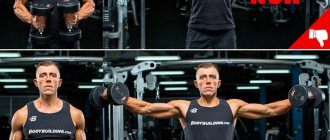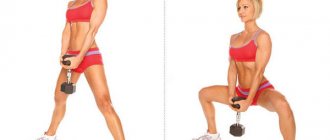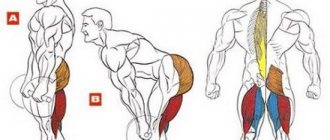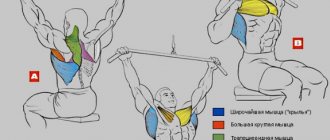Technique
Starting position:
- Stand up straight. Place your feet shoulder-width apart, and slightly turn your feet with your toes outward, literally 10-20 degrees. Bend your knees slightly.
- The standing biceps curl can be performed with either a straight bar or an EZ-shaped bar.
- Take the bar from below so that your palms face the ceiling. The width of the grip should be equal to the width of the shoulders.
- Look ahead, your back remains straight.
- The elbows are not turned out, but barely bent.
Exercise:
- As you inhale, bend your elbows and lift the barbell up until it is just above your nipples.
- At the top point, feel the tension in your biceps, take a short pause for a second or two. Make sure that your elbows are fixed in one position and do not move.
- Slowly lower the bar down until the bar is in its starting position. At the bottom point, do not straighten your arms completely.
Lifting the barbell on a “prayer bench” (Scott bench)[edit | edit code]
Read the main article:
Scott Bench Curls
Inventory
: “prayer bench”, barbell.
Core muscles
: brachialis, biceps.
Additional muscles
: all muscles of the forearm.
Source:
“Bodybuilding.
Book trainer" .
Editor:
Oksana Usoltseva
Ed.
: Eksmo 2013
Level of training
: from beginner to professional.
The main load when bending your arms on a “prayer bench” falls on the lower biceps.
Emphasis on the wrists
Throughout the entire exercise, the position of the wrists does not change!
Step 1
. Sit on the “prayer bench” and place your hands on the stand. Grab the barbell with a wide grip.
Step 2
. Bend your elbows and lift the barbell to face level.
Step 3
. Slowly lower the barbell to the starting position.
Load distribution can vary significantly depending on the angle of the bench, grip width and range of motion. Therefore, take your time, but do several warm-up sets, changing the described positions to find your version. The most difficult part of the amplitude is the beginning of the ascent. On the last reps, do not lower the barbell to the starting position, leaving your elbows slightly bent. This will increase the intensity of the exercise.
Muscles working when lifting the barbell on the “prayer bench”: 1 - biceps; 2 - shoulder; 3 - brachioradial; 4 - flexor carpi radialis; 5 - muscles of the forearm
#2 Weight loss
The negative phase of the movement is key. During the downward movement of the barbell, damage to the muscle fibers mainly occurs, which triggers the mechanism of recovery and muscle growth.
If you drop the weight and don't provide any resistance from the bar on the way down, you can easily deprive your biceps of the load for at least half of the exercise.
Correcting the mistake is quite easy - you need to lower the weight with the same tension as when lifting it. That is, in the negative phase of the movement, your biceps must be constantly tense , and you must resist gravity throughout the entire trajectory of movement until the bar reaches the lowest point.
Correct technique
Technique:
- Starting position – back straight, legs shoulder-width apart, feet parallel, toes slightly apart. Grab the bar with an underhand grip (palms facing up). The spine is in a neutral position, do not strain the shoulder girdle.
- As you inhale, slowly, without jerking, lift the barbell until your forearms are vertical. Do not press your elbows to your body or spread them to the sides. Lift weights using your biceps only. You cannot use inertia, wrists, bend your back, or help yourself with your torso. During a short pause at the top, turn up the heat with even more muscle tension.
- Exhale as you lower the barbell down, straightening your arms completely. The body remains motionless.
Note:
- During execution, you cannot raise or pull your shoulders back. There is a risk of injury to the spine. In addition, a significant part of the required load is removed.
- If your elbows are not locked in the correct position and are flopping around during the press, you will not reach the peak of the contraction. The load on the main muscle will be weakened.
- Select the optimal projectile weight. If it's too heavy, you'll be forced to push it with your hips first. This is absolutely not what is needed. In addition, you risk injuring your lower back. Excess weight limits the range of movement. And to build muscle, it is important to stretch it at the bottom to the fullest. It makes sense not to fully straighten your arms below if the goal is to increase the peak of your biceps.
#3 Small range of motion
This mistake is not critical, but its price is a decrease in the effectiveness of the exercise. At the top point, the bar should be at the level of the top of the pecs , and the biceps will contract to the maximum. If the trajectory of movement is incomplete, the biceps will contract at half strength, and the effectiveness of the exercise will decrease.
Make it a rule. At the top point the angle should be less than 90 degrees.
Some athletes use advanced barbell curls. At the top point, they additionally raise their elbows up so that the bar is at chin level. This technique allows you to contract the biceps even more, but it is better to use it after you have mastered the basics. It looks like this:
What muscles are involved?
When performing standing biceps curls, the biceps brachii muscle or biceps muscle is primarily involved. The biceps is a large, clearly visible muscle on the front of the shoulder. Since ancient times, it has been established and established that a well-developed biceps gave an assessment of a person’s athletic training, and is still considered the standard of muscle development.
The biceps consists of two bundles or as they are also called heads. The long bundle is located on the outer part of the arm, adjacent to the upper edge of the shoulder blade. The short tuft is located in the inner part of the arm, but is adjacent to the lower part of the shoulder blade.
As a result, two bundles form a tuberosity in the area of the radius. The main function of the biceps is flexion at the elbow joint, and lifting a load with the help of flexions, which is why all exercises for the biceps consist of these movements.
Next come the muscles of the forearms. During the exercise, the muscles of the forearms work in a static mode, helping to hold the load and control movements. The forearms consist of large and many small muscle groups, but the brachyradialis and brachialis are responsible for the quality of the exercise.
#4 Using the same grip
Our body quickly adapts to the same type of stress. So if your grip width stays the same, you will easily fall into this trap and reach a training plateau.
to change your grip width from time to time . A narrow grip will help to better work the outer part of the biceps head (short bunch), and a wider inner one (long bunch).
You can also do the standing biceps curl with a reverse grip, and also experiment with the types of barbell. Straight will give more emphasis to the biceps, EZ will help you hold the bar with a more comfortable grip and will work the brachialis. Finally, you can completely abandon the barbell in favor of dumbbells. In short, the exercise has as many variations as the numbers after the decimal point in the number “Pi.”
Reverse grip biceps curl
The exercise is aimed at developing the brachialis, a muscle located under the heads of the biceps and running along the elbow to the forearm. Increasing, the brachialis from the inside raises the outer head of the biceps, giving the arm additional volume.
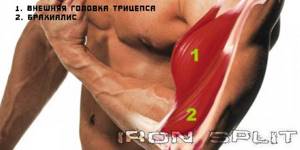
Brachialis only works when the hand is turned to the side (hammer curls for biceps with dumbbells) or palm down.
Execution technique
In this exercise, you do not need to strive to set strength records. Take a light weight that you can perform 10-12 reps with.
- Stand up straight.
- Grab the barbell with a medium overhand grip.
- Press your elbows towards your body.
- Lower your arms down, straightening them completely.
- As you exhale, bend your elbows, raising the barbell to your chest.
- Pause at the top.
- Slowly lower the barbell to the starting position.
- Perform 10-12 repetitions.
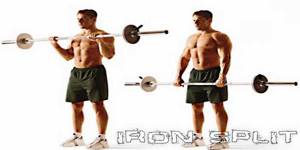
You can use both a straight bar and an EZ bar in this exercise. The elbows should remain pressed to the body during movement.
#5 Incorrect work at the bottom point
Few people pay attention to the end of the exercise, when the weight is at the lowest point. But the devil is in the details.
The bottom is a great chance to stretch the biceps, but many people don't take advantage of it. Instead, they leave the angle at the elbows at 20, 30, or even a good 45 degrees. You definitely won’t stretch your biceps in this position.
What should be done? At a minimum, make sure that at the bottom point the angle at the elbows is almost 180 degrees , and the biceps are well stretched. You should really feel the latter. Only after this can you start a new repetition.
Curling arms with a barbell
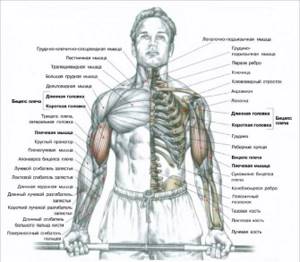
Technique
Starting position: standing, with a straight back. Hold the barbell with an underhand grip slightly wider than shoulder width:
- take a breath and, bending your arms, lift the barbell;
- At the end of the movement, exhale.
Performing the exercise
What muscles work
This exercise involves the biceps , brachialis and, to a lesser extent, the brachioradialis, pronator teres muscles, and all flexors of the hand and fingers. To avoid torso deviation, tighten the muscles of your buttocks, abdomen and back.
Variants of the exercise for curling arms with a barbell:
Use different grip widths to accentuate the load:
- - on the long head of the biceps (narrow grip of the bar);
- - on the short head of the biceps (with a wide grip of the bar).
As you contract your biceps , lift your elbows slightly up using your deltoids. Perform the exercise with maximum control over the movement, to do this, straighten your back and bring your shoulder blades together as much as possible. You can also bend your arms more emphatically, pressing your lower back against the wall, moving your feet half a step forward.
If you want to do this exercise with a very heavy weight, lean your torso slightly forward (barbell down) and then bend your arms to straighten your torso back, giving the bar extra acceleration.
This technique should be used very carefully to avoid injury to yourself. This option requires experience and developed abdominal and lower back muscles to protect your movements.
When training biceps with a barbell, it is very important to take into account the individual characteristics of morphology.
In some individuals in a certain anatomical position (when the arms are along the body and the hands are in a supinated position, that is, with the thumb outward), the angle at the elbow is clearly pronounced, and the forearm is curved outward.
This feature forces individuals with this design to excessively rotate their wrists inward when curling their arms with a straight barbell, which leads to pain.
Bent barbell curl
In such cases, we recommend using a barbell with a curved bar so as not to injure the wrist joints.
Note: this curvature most often occurs in women.
Video
#7 Body work
Most trainers talk about this mistake, so it comes last on our list. If you are not familiar with her, then the essence of the matter is as follows.
During the movement, many begin to engage other muscles of the body, helping the barbell reach the top point. As a result, body swings : the body changes position during the exercise, and the lower back works almost like during hyperextensions.
This technique is called cheating and can be used if you know exactly how to use it. In other cases, core work easily takes the load off the biceps, and the muscle stops participating in the work. The result is jars the size of Bonduelle peas.
One of the causes of body swing is too much weight. In an effort to get it off the ground, athletes begin to help themselves with their bodies. So don't chase weight, unless you're aiming to be a powerlifter, of course.
